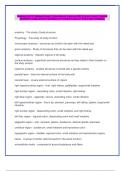Anatomy SLCC Salloum Exam 1 | Questions & Answers (100 %Score) Latest Updated
2024/2025 Comprehensive Questions A+ Graded Answers | With Expert Solutions
anatomy - The study of body structure
Physiology - The study of body function
microscopic anatomy - structures too small to be seen with the naked eye
gross anatomy - Study of structures that can be seen with the naked eye
regional anatomy - Specific regions of the body
surface anatomy - superficial and internal structures as they relate to their location on
the body surface
systemic anatomy - studies structures involved with a specific activity
parietal layer - lines the internal surface of the body wall
visceral layer - covers external surface of organs
right hypochondriac region - liver, right kidney, gallbladder, large/small intestine
right lumbar region - ascending colon, small intestine, right kidney
right illiac region - appendix, cecum, ascending colon, small intestine
left hypochondirac region - liver's tip, stomach, pancreas, left kidney, spleen, large/small
intestine
right lumbar region - descending colon, small intestine, and right kidney
left illiac region - sigmoid colon, descending colon and small intestine
epigastric region - liver, stomach, spleen, duodenum, adrenal glands, pancreas
umbilical region - duodenum, small intestine and transverse colon
hypogastric region - bladder, sigmoid colon, small intestine and reproductive organs
tissue - A group of similar cells that perform the same function.
extracellular matrix - composed of ground substance and fibers
, epithelial tissue - lines every body surface and all body cavities
cellularity - composed almost entirely of cells
polarity - epithelial cells have an apical surface and a basal surface
attachment - basal surface attaches to basement membrane
avascularity - no blood vessels
innervation - Epithelia are richly innervated to detect changes in environment
high regeneration capacity - Because the apical surface is constantly exposed to the
environment, epithelial cells are frequently damaged or die; they are replaced as quickly
as they are lost
characteristics of epithelial tissue - attachment, avascularity, innervation, high
regeneration capacity
functions of epithelial tissue - physical protection, selective permeability, secretions,
sensations
basement membrane - Cells at the base of an epithelial layer are attached to this.
intercellular junctions - tight junctions, adhering junctions, desmosomes, gap junctions
tight junctions - gatekeepers between external and internal environments.
adhering junctions - cement cells together
desmosomes - button or snap between adjacent cells
gap junctions - allows cells to communicate with each other by the flow of ions and
small molecules
keratin - hard protein material found in the epidermis, hair, and nails
endocrine gland - a ductless gland that secretes hormones directly into the bloodstream
exocrine gland - possess ducts and their cells secrete products into their ducts
exocrine gland structure - microvilli, mucin, rough ER, mitochondria, golgi apparatus,
nucleus




